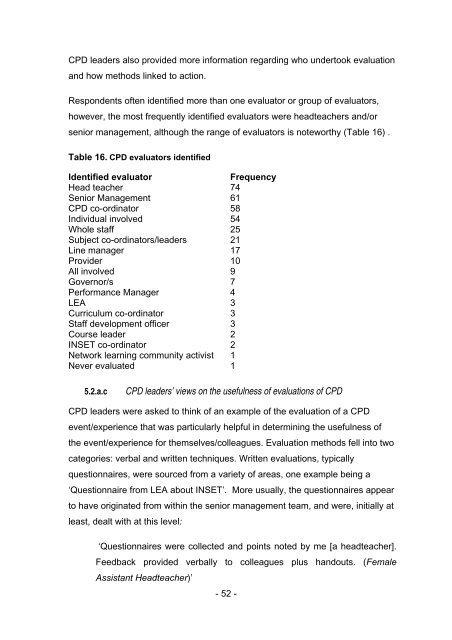Evaluating the Impact of Continuing Professional Development (CPD)
Evaluating the Impact of Continuing Professional Development (CPD)
Evaluating the Impact of Continuing Professional Development (CPD)
You also want an ePaper? Increase the reach of your titles
YUMPU automatically turns print PDFs into web optimized ePapers that Google loves.
<strong>CPD</strong> leaders also provided more information regarding who undertook evaluation<br />
and how methods linked to action.<br />
Respondents <strong>of</strong>ten identified more than one evaluator or group <strong>of</strong> evaluators,<br />
however, <strong>the</strong> most frequently identified evaluators were headteachers and/or<br />
senior management, although <strong>the</strong> range <strong>of</strong> evaluators is noteworthy (Table 16) .<br />
Table 16. <strong>CPD</strong> evaluators identified<br />
Identified evaluator<br />
Frequency<br />
Head teacher 74<br />
Senior Management 61<br />
<strong>CPD</strong> co-ordinator 58<br />
Individual involved 54<br />
Whole staff 25<br />
Subject co-ordinators/leaders 21<br />
Line manager 17<br />
Provider 10<br />
All involved 9<br />
Governor/s 7<br />
Performance Manager 4<br />
LEA 3<br />
Curriculum co-ordinator 3<br />
Staff development <strong>of</strong>ficer 3<br />
Course leader 2<br />
INSET co-ordinator 2<br />
Network learning community activist 1<br />
Never evaluated 1<br />
5.2.a.c<br />
<strong>CPD</strong> leaders’ views on <strong>the</strong> usefulness <strong>of</strong> evaluations <strong>of</strong> <strong>CPD</strong><br />
<strong>CPD</strong> leaders were asked to think <strong>of</strong> an example <strong>of</strong> <strong>the</strong> evaluation <strong>of</strong> a <strong>CPD</strong><br />
event/experience that was particularly helpful in determining <strong>the</strong> usefulness <strong>of</strong><br />
<strong>the</strong> event/experience for <strong>the</strong>mselves/colleagues. Evaluation methods fell into two<br />
categories: verbal and written techniques. Written evaluations, typically<br />
questionnaires, were sourced from a variety <strong>of</strong> areas, one example being a<br />
‘Questionnaire from LEA about INSET’. More usually, <strong>the</strong> questionnaires appear<br />
to have originated from within <strong>the</strong> senior management team, and were, initially at<br />
least, dealt with at this level:<br />
‘Questionnaires were collected and points noted by me [a headteacher].<br />
Feedback provided verbally to colleagues plus handouts. (Female<br />
Assistant Headteacher)’<br />
- 52 -

















